Transport Systems in Plants and Animals
Classified in Biology
Written on in  English with a size of 31.41 KB
English with a size of 31.41 KB
Su,Aalo Iyo Jawabo biology
1. a) i) Define transport
- Movement of substances from one part of the body to another
ii) Explain the necessity of transport in plants and animals
make nutrients move from one point to another
movement of respiratory gases i.e. oxygen and carbon IV oxide
elimination of metabolic wastes
movement of hormones
movement of water
movement of salts
- movement of enzymes
b) i) Describe the structure and function of root hair
root hairs are found near the root tip
they are cells with elongated finger-like projections which are in contact with soil particles
they are permeable to water and mineral salts hence are used to absorb Water and mineral salts
- There large number offers a large surface area for absorption of water and mineral salts.
ii) State ways in which the root hairs are adapted to their functions
the root hair is long/narrow/numerous to increase surface area for absorption of water and mineral salts
many mitochondria in cytoplasm to supply energy for active transport of mineral salts
- are thin walled to speed up rate of absorption of Water and mineral salts
c) i) Compare the internal structure of a dicotyledonous root and a monocotyledonous root
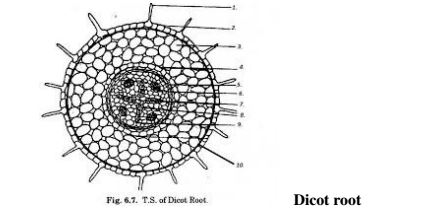
Monocot root

ii) State the similarities and differences between a dicotyledonous and monocotyledonous root
Similarities
both used for anchorage and absorption of water and mineral salts
both have root hairs, epidermis, pericycle, cortex, endodermis and vascular bundles
(xylem and phloem)
- both may be used to store food/storage organs
Differences
Monocotyledonous
phloem and xylem are arranged in ring form alternately
- pith present
Dicotyledonous
phloem lies between radial rays of central xylem(star shaped)
- pith absent
iii) Compare the internal structure of a monocotyledonous and dicotyledonous stem
Monocotyledonous stem
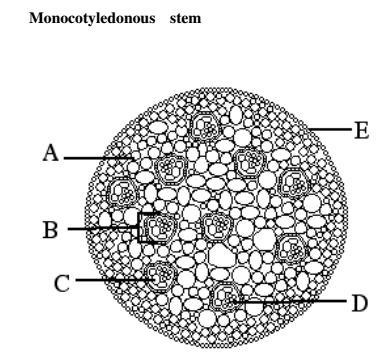
Dicotyledonous stem
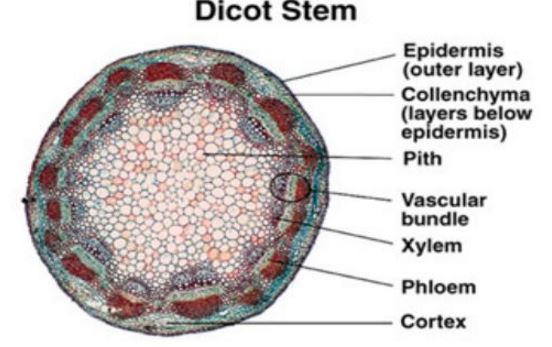
i) Give the similarities and differences between a monocotyledonous and dicotyledonous stem
Similarities
both are used for protection
both conduct water, salts and food
- both have epidermis, cortex, pericycle and vascular bundles
Differences
Monocotyledonous
vascular bundles are many and scattered
some have hollow pith or pith is absent
- no cambium layer therefore cannot
- undergo secondary growth very
- little cortex
Dicotyledonous
vascular bundles are few and arranged in a concentric ring near the epidermis
- pith large and well developed
State the differences between the internal structure of a root and a stem.
no cambium layer therefore cannot
undergo secondary growth
very little cortex
- presence of cambium therefore
undergoes secondary growth
- cortex has several layers of cells
c) i) Name the transport structures of a flowering plant
xylem vessels and tracheids transport water and mineral salts from the soil
- Phloem vessels translocate manufactured food from leaves to other parts of the body
ii) State the ways in which xylem vessels are adapted to their function
lignified/thickened to prevent collapsing
narrow to facilitate capillary
no cross walls for continuous flow/column of water
- have bordered pits for lateral movement of water
a) i) Why do flowering plants need water?
photosynthesis
transport
turgidity w h helps in plant support
solvent i.e. medium for chemical reactions
cooling effect during transpiration
- seed germination
ii) Describe the movement of water from the soil to the leaves of a tall plant
Soil water exists as a thin film in the soil, between soil particles
the concentration of cell sap of root hair is greater than that of the surrounding solution in the soil, thus drawing the Water molecules across the cell wall and cell membrane into the root hair by osmosis
water drawn into the root hair cell dilutes the cell sap making it less concentrated than that in the adjacent cortex cells of the root
- due to osmotic gradient water moves from the root hair cells into the cortex by osmosis, from cell to cell by osmosis, across the endodermis by active transport into xylem vessels of the root that conduct water into xylem vessels of the stem into xylem vessels of the leaves
Stem
Once in the stem water moves up the plant aided by the narrowness of the xylem vessels (capillary), root pressure, attraction of water molecules to each other (cohesion).
Attraction of water molecules to the Walls (adhesion) from the stem water enters the xylem of leaves
- water moves in the xylem vessels of the stem in a continuous (uninterrupted) water column up to the tree leaves
Leaves
once in the leaves water moves into the mesophyll cells by osmosis as water vaporizes from the spongy mesophyll cells their sap becomes more concentrated than the adjacent cells as the result water flows into the cell from other surrounding cells which in turn takes in water from xylem vessels within the leaf veins this creates a pull(suction force) called transpiration pull that pulls a stream of water from xylem vessels in the stem and roots .
- The transpiration pull maintains a continuous column of water from the roots to the leaves.
iii) Name the process by which mineral salts enter into a plant
active transport
- diffusion
i) Explain the forces that make water and mineral salts move through a plant
mineral salts are taken up due to diffusion because of the concentration gradient between the mineral ions in sap and those in soil solution
active transport involves energy in form of ATP due to respiration which forces mineral salts through a plant against a concentration gradient
water moves by osmosis through a semi-permeable membrane of root hairs and between cells of stem
in stem water moves by cohesion(attraction of water molecules to each other)
it also moves by adhesion(attraction of water molecules to walls)
capillarity is due to narrowness of xylem vessels
transpiration pull occurs When Water vapour evaporates from sub-stomatal chambers into the air
- root pressure is a force that pushes Water up the stem from the roots and causes guttation /exudation
ii) Explain the uptake of mineral salts by plants
plants require mineral salts for metabolism and proper functioning of their bodies
mineral salts are taken up from the soil into the root hairs in form of solution by active
transport which requires energy
active transport involves substances called carriers taken up together with water and are then carried to the stems and leaves
- the main process involved in uptake and movement of mineral salts is active transport
b) i) What is transpiration?
- loss of water from plant to the atmosphere
ii) Name the sites through which transpiration takes place in a plant
stomata (stomatal transpiration)
lenticels (lenticular transpiration)
- cuticle(cuticular transpiration)
iii) State the importance of transpiration to plants
cooling the plant
transport of water
transport of mineral salts
- excretion of excess Water from plants
excess transpiration causes wilting
i) Explain the structural factors that affect the rate of transpiration in plants
number of stomata i.e. the more the stomata the higher the rate and vice versa
turgidity of the guard cells which control the opening and closing of stomata when they are open transpiration rate is high
size of leaves where the larger the surface area the higher the rate of transpiration
leaf fall leads to lower rate of transpiration and also drying of leaves reduces rate of transpiration
- Thin cuticle reduces distance through Which water vaporizes hence increase transpiration rate. Absence of cuticle also increase rate of transpiration
ii) Explain the environmental factors that affect rate of transpiration in plants
high temperature increases rate of transpiration and low temperature reduces the rate
humidity when high increases rate and when low reduces the rate
transpiration rate is higher in moving air (wind) than in still air
high light intensity increases internal temperature hence higher rate of evaporation leading to higher rate of transpiration
availability of water in the soil leads to more absorption hence more loss to the atmosphere
- atmospheric pressure when high leads to more evaporation and when low leads to low rate evaporation of water
iii) State the structural differences between xylem vessels and sieve tubes
sieve tubes have cross wall while xylem vessels have none
xylem vessels are lignified while sieve tubes are not
- Sieve tubes have cytoplasm elements while xylem vessels have none.
iv) State the adaptations of plants which enable them to reduce water loss
thick waxy cuticle
reduced leaf size/thorns/spines
shedding of leaves
Sunken stomata. Water vapour accumulates in the depression of stomata lowering the water vapour concentration gradient leading to lower rate of evaporation
- rolling of leaves
v) State the factors that cause increase in the rate of transpiration from leaves
increased light intensity
low relative humidity
- temperature
vi) Explain how drooping of leaves on a hot sunny day is advantageous to a plant
- reduces surface area exposed to sun reducing cuticular transpiration
c) Explain how aquatic and terrestrial plants are adapted to deal with problems of transpiration
a. Mesophytes
they grow in soils with enough water
water loss is perfectly balanced by absorption of more from the soil
- no special adaptations
b. Xerophytes
they grow in dry conditions
root grow very deep to absorb water
succulent/fleshy leaves to store water
few stomata which are sunken
thickened waxy cuticle
leaves are hairy and often folding
some leaves are needle-like/spines or scales
leaf surfaces are reduced i.e. small leaves
- all these adaptations are to reduce water loss
c. Hydrophytes
plants that grow in water
presence of sclereids
leaves are broad
leaves have many stomata on upper side only (none on the lower surface)
some leaves float on water
absence or reduced leaf cuticle
large air spaces
some leaves are submerged
- poorly developed or reduced vascular bundles
d) i) What is translocation
- transfer of manufactured food substances to the parts where they are required
ii) Name the tissue which is responsible for translocation of manufactured food in flowering plants
- phloem tissue
iii) Name the processes that bring about the translocation of manufactured food
active transport
Diffusion
Mass flow
- Cytoplasmic streaming
iv) Draw a labeled diagram to represent phloem tissue
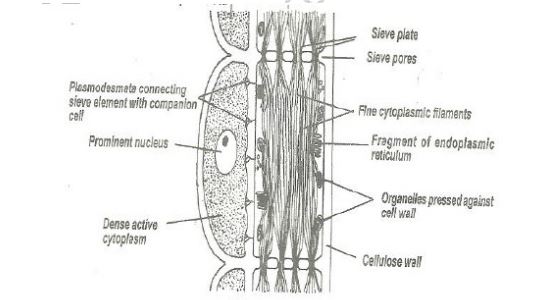
ii) State the functions of the labbeled structures cytoplasmic strands
- translocation
Companion cell
supply nutrients to sieve tube element
supply energy for translocation
- regulates activities of tube cells/elements
Sieve tubes element
- conduct food down the stem
iii) name the compounds that are translocated in phloem
sugars
amino acids
hormones e.g auxins
oils/lipids
resins
- vitamins
Describe an experiment you would carry out in order to demonstrate that phloem transports manufactured food substances in a plant
a. Ringing experiment
cut a ring in the bark including the phloem from the stem of a woody plant
phloem is found next to or just beneath the bark
observe daily for some time(more than three weeks)
a swelling of the bark appears above the ring
this is due to accumulation of food from leaves
the bark of a second similar plant is removed carefully leaving the phloem intact
- a swelling does not appear
ii) Use the radio-active tracers
plant is exposed to carbon containing radio-active carbon C14
C14 is found in the end products of photosynthesis
It is finally detected in phloem
- C14 is found to move in both directions
iii) Collecting exudate from stylets of aphids
aphids feed on certain plant phloem using their stylets
aphid mouth parts are dissected using a sharp razor
exudes from the mouth parts are collected and then analyzed
sucrose is found to be a major component of the exudates
- this proves that phloem translocates manufactured food substances
e) Describe an experiment you would carry out to demonstrate that xylem transports water
i. Either
cut a stem of a young plant or twig of a tree under water
or else uproot a young herbaceous plant and wash the soil gently
put some water in a beaker and add a dye i.e. eosin or red ink and place the cut stem or young plant in a beaker
leave for time e. g. between 20 minutes and one hour
cut a thin section of stem or leaf
mount it on a slide and examine under a microscope
observe and note the distribution of the dye or ink
- the dye appears only in the xylem vessels
ii. OR
use radio-active tracers, C14 in form of carbon
ring a plant then put it in a container containing radio-active phosphorous solution
- The radio-active phosphorus is later detected in the leaves.
2. a) i)List the components of animal transport systems
system of blood vessels in which materials are circulated round the body
blood, a fluid medium which contains dissolved substances and cells
- the heart, a pumping mechanism which keeps blood in circulation
ii) Distinguish between closed and open circulatory systems
closed system has blood vessels through which blood moves eg vertebrates
- open system has no blood vessels hence blood is in direct contact with tissues e. g arthropoda
iii) What are the advantages of the closed circulatory system over open circulatory system?
Closed system has continuous vessels hence able to generate high pressure
Circulates blood over longer distance
Circulates blood at a faster rate
Efficient transport of nutrients and waste products
- Animals are more active
iv) Distinguish between single circulatory system and double circulatory system Single circulatory
blood passes through the heart once in a complete circuit of the body
Double circulation
blood enters the heart twice in a complete circulation
Pulmonary circulation from the heart to lungs and back
- Systemic circulation from the heart to body systems and back
b) i) Describe the general layout of the transport system in mammals
blood which is a fluid tissue of the body carrying food substances, oxygen, carbon IV oxide and metabolic wastes
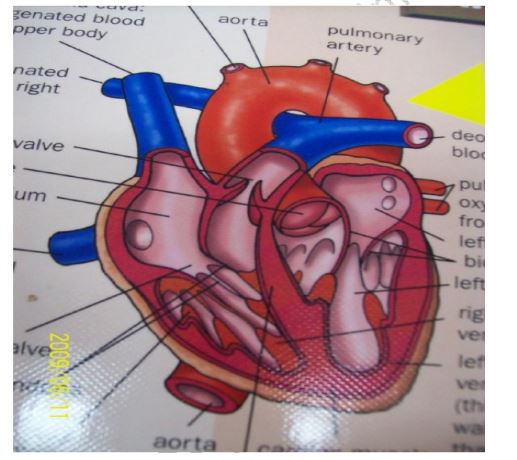
arteries which are elastic tubes carrying blood from the heart to cells
veins which are blood vessels carrying blood away from the cells to the heart
- capillaries which are extremely numerous and are microscopic channels connecting arteries to veins
ii) Describe the structure and function of the mammalian heart
the heart is a four-chambered hollow muscle located in the thoracic cavity
it consists of two small receiving chambers, the atria(auricles) and two larger pumping chambers, the auricles
the left ventricles is the most powerful and has the thickest walls
this is because it is the chamber which pumps blood throughout the body
each time it contracts, blood is forced out into the elastic arteries(aorta)
blood moves on to the capillaries
from capillaries blood moves to veins and back to the heart through the vena cava
from vena cava it enters into right auricle which contracts and pumps blood into the right ventricle
right ventricle pumps blood into the lungs through the pulmonary artery
blood releases carbon IV oxide to lungs and picks oxygen then returns to left auricle
left auricle pumps blood into left ventricle
left ventricle then pumps blood into the aorta and into arteries, starting the process all over again
- both auricles contract simultaneously while both
iii) Explain how the mammalian heart is adapted to performing its functions
the heart is made of muscles that contract and relax synchronously without requiring nervous stimulation
nerve supply however, determine contraction strength and frequency
the heart is divided into four chambers
The right atrium is connected to the right auricle. It receives blood from the whole body.
The blood is pumped from the left atrium to the right ventricle
- To avoid flow back into the right atrium, a valve is present between the two chambers
the tricuspid valve
The right ventricle pumps blood to the lungs
This is facilitated by the presence of pulmonary artery
A valve is also present to avoid blood flowing back from the pulmonary artery to the right ventricle
Blood from the lungs enters the heart through the pulmonary vein into the left atrium.
When the left atrium contracts, blood flows into the left ventricle
Blood will not flow back into the left atrium because of the presence of bicuspid valve(mitral)
The left ventricle is connected with the aorta and when it contracts, blood flows into the aorta for distribution into the whole body
The heart muscle surrounding the left ventricle is thicker than that surrounding the right ventricle to be able to generate enough pressure to push blood to the whole body
A pace-maker is present in the heart muscle to initiate and synchronise contractions.
- For the heart muscle to be well nourished and be provided with enough oxygen and carbon IV oxide removal, it is supplied with blood by the coronary arteries and drained by the coronary veins
iv) Explain why blood leaving the lungs may not be fully oxygenated
under ventilation of the lungs
blockage of alveoli (air sacs)
- high cardiac frequency i.e. high rate of pumping of blood in the heart
e) Describe the structure and functions of the blood vessels
i. Arteries
carry away blood from the heart
carry oxygenated blood except pulmonary artery which takes blood from the heart to lungs for oxygen
have thick, muscular walls
are elastic
have narrow lumen
- all these adaptations are required to withstand high pressure caused by heartbeat
ii. Capillaries
link arterioles and venules to arteries and veins
small in diameter to increase pressure resistance for materials to filter out
thin walled as they consist of a single layer of cells to allow diffusion of substances e.g leucocytes to tissues
thin walled to allow presence of intercellular spaces
large number i.e. numerous to provide a large surface area for exchange of materials
have sphincter muscles at the junction of the arterioles and capillaries to control movement of blood into them
- lie close to the body for easy exchange of materials
iii. Veins
carry blood back to the heart
all carry deoxygenated blood except pulmonary vein that carries blood from the heart to lungs
have thinner Walls than arteries
have valves to prevent back flow of blood
- have wide lumen
b) i) State the ways in which the composition of blood in the pulmonary arterioles differs from that in the pulmonary venules
pulmonary arterioles
- deoxygenated
- high carbon iv oxide
- low oxygen
more nutrients
